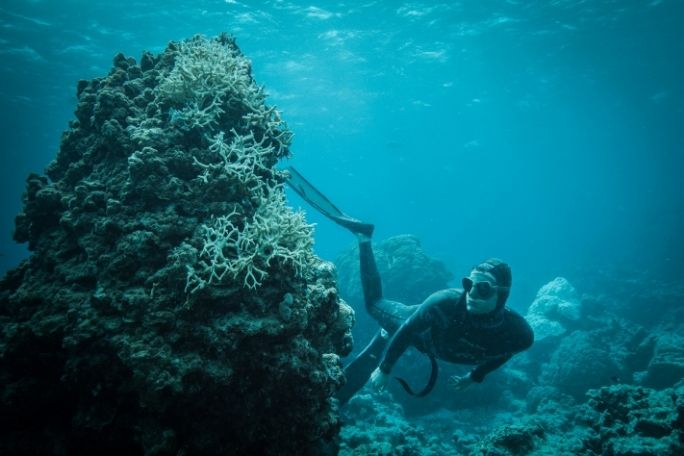Lesson summary
This lesson incorporates clips from Blue The Film as learning inspiration. In this finding out lesson, students will use visible thinking routines to respond to a clip from Blue The Film that explores the state of the reef, coral bleaching and the impact of pollution, overfishing, and ocean acidification. They will enhance their understanding of creative writing and meaning communicated through creative writing techniques. Using visual images and information about the state of the reef as stimulus, students will develop their creative writing and editing skills. They will select language and creative writing techniques to create their own descriptive passages about coral reefs.
Learning intentions:
Students will...
- learn about how language can be used powerfully through creative modality and the concept of ‘show, don’t tell’.
- learn about the state of the reef and how language can be used to communicate this condition and potential.
Success criteria:
Students can...
- articulate facts about coral reefs and the issues contributing to their current status on Australian coastlines.
- demonstrate the use of creative writing techniques in short descriptive passages about coral reefs, applying the principle of ‘show, don’t tell’ to their writing.
- demonstrate editing skills in identifying grammatical errors and providing constructive feedback to their peers.
Lesson guides and printables
Lesson details
Curriculum mapping
Australian curriculum (8.4) content descriptions:
Year 7 English:
- Understand how modality is achieved through discriminating choices in modal verbs, adverbs, adjectives and nouns (ACELA1536).
- Plan, draft and publish imaginative, informative and persuasive texts, selecting aspects of subject matter and particular language, visual, and audio features to convey information and ideas (ACELY1725).
- Edit for meaning by removing repetition, refining ideas, reordering sentences and adding or substituting words for impact (ACELY1726).
Syllabus outcomes: EN4-2A, EN4-3B, EN4-4B
General capabilities: Literacy, Critical and Creative Thinking
Cross-curriculum priority: Sustainability
Relevant parts of Year 7 English achievement standards: Students demonstrate understanding of how the choice of language features, images and vocabulary affects meaning. They understand how the selection of a variety of language features can influence an audience. They create structured and coherent texts for a range of purposes and audiences. Students demonstrate understanding of grammar, use a variety of more specialised vocabulary and accurate spelling and punctuation.
Unit of work: Blue The Film: Our Oceans and Our Future
Time required: 90 mins.
Resources required
- Student Worksheet – one per student
- Device capable of presenting a clip to the class
- Coral Bleaching Stimulus Images
- Coral Reefs Factsheet
- Creative Writing Tips Factsheet
- Editing Checklist
Skills
This lesson is designed to build students’ competencies in the following skills:
- Communication
- Creativity
- Critical thinking
- Global citizenship
- Social skills
Additional info
Level of teacher scaffolding: Low – lead students in discussion.
Blue is a feature documentary film charting the drastic decline in the health of our oceans. With more than half of all marine life lost and the expansion of the industrialization of the seas, the film sets out the challenges we are facing and the opportunities for positive change. Blue changes the way we think about our liquid world and inspires the audience to action. Find out how to screen or download the film here. Along with the film is an ambitious global campaign to create advocacy and behaviour change through the #oceanguardian movement. To become an ocean guardian, see the website.


Welcome back!
Don't have an account yet?
Log in with:
By signing up to Cool.org you consent and agree to Cool's privacy policy to
store, manage and process your personal information. To read more, please see
our privacy policy here(Opens in new tab).
Create your free Cool.org account.
Many of our resources are free, with an option to upgrade to Cool+ for premium content.
Already have an account?
Sign up with:
By signing up to Cool.org you consent and agree to Cool's privacy policy to
store, manage and process your personal information. To read more, please see
our privacy policy here(Opens in new tab).